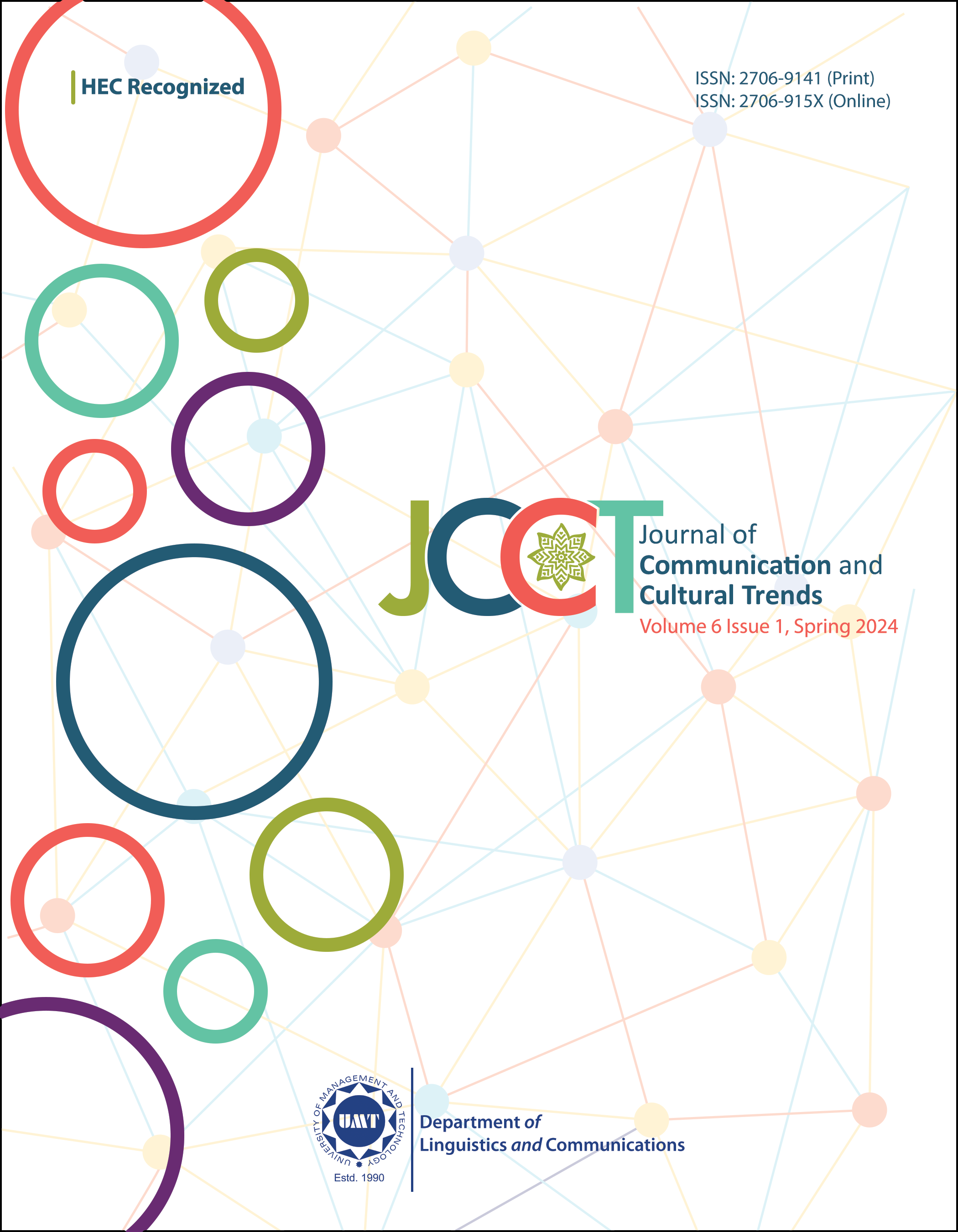Phonemic Modification Strategies Used by Pahari ESL Learners while Learning English Consonant Clusters
Abstract
 Abstract Views: 0
Abstract Views: 0
The current study attempted to examine different modification strategies used by Pahari ESL (English as Second Language) learners. Pahari ESL learners use different types of modification strategies to acquire consonant clusters that are not found in their native language. The data was collected by providing a list of 216 words which were various combinations of the place of articulation and manner of articulation. About 10 participants were selected from the district Bagh. The participants belonged to intermediate academic background. The learners were asked to pronounce those clusters three times. These recordings were analyzed by using Praat software. For acoustics analysis, three participants were selected from them. The current study showed that Pahari learners use deletion, lenition, and fortition as modification strategies to deal with the consonant clusters that are not found in their language. This study further indicated that learners used spirantization, approximentization, voicing, change in manner, stopping insertion of consonants, devoicing, and lengthening of vowels as well.
Downloads
References
Al-Otaibi, A. B. N. (2021). Interlanguage cluster production of L2 English by L1 Saudi Arabic speakers. Arts for Linguistic & Literary Studies, (12), 7–21. https://doi.org/10.53286/arts.v1i12.786
Al-Saidat, E. M. (2010). Phonological analysis of English phonotactics: A case study of Arab learners of English. The Buckingham Journal of Language and Linguistics, 3(1), 121–134. https://doi.org/10.5750/bjll.v3i0.26
Bayley, R., & Preston, D. R. (Eds.). (1996). Second language acquisition and linguistic variation (Vol. 10). John Benjamins Publishing.
Carlisle, R. S. (1994). Markedness and environment as internal constraints on the variability of interlanguage phonology. In M. Yavas (Ed.), First and second language phonology (pp. 223–249). Singular Publishing Company.
Chang, F. C. (2004). Chinese-speaking EFL learners’ performances of processing English consonant clusters (Paper presentation). International Conference on English Instruction and Assessment National Chiayi University, Chiayi, Taiwan.
Chomsky, N. (1981). Lectures on government and binding. Foris Publications.
Crystal, D. (2004). The language revolution. Wiley-Blackwell.
Dupoux, E., Kakehi, K., Hirose, Y., Pallier, C., & Mehler, J. (1999). Epenthetic vowels in Japanese: A perceptual illusion? Journal of Experimental Psychology: Human Perception and Performance, 25(6), 1568–1578. https://doi.org/10.1037/0096-1523.25.6.1568
Dyson, A. T., & Paden, E. P. (1983). Some phonological acquisition strategies used by two-year-olds. Journal of Childhool Communication Disorders, 7(1), 6–18. https://doi.org/10.1177/152574018300700102
Erling, E. J., & Bartlett, T. (2006). Making English their own: The use of ELF among students of English at the FUB. Nordic Journal of English Studies, 5(2), 9–40
Fleischhacker, H. A. (2005). Similarity in phonology: Evidence from reduplication and loan adaptation (Publication No. 3208408) [Doctoral dissertation, University of California]. ProQuest Dissertations Publishing. https://tinyurl.com/2k7a9bp9
Giannelli, L., & Savoia, L. (1979). L'indebolimento consonantico in Toscana. Rid, Italian Dialectlogy Magazine, 4, 39–101.
Graddol, D. (2006). English next: Why global English may mean the end of English as a foreign language. British Council.
Grunwell, P. (1987). Clinical phonology (2nd ed.). Croom Helm.
Honeybone, P. (2001). Lenition inhibition in Liverpool English. English Language & Linguistics, 5(2), 213–249. https://doi.org/10.1017/S1360674301000223
Honeybone, P. (2012). Lenition in English. In T. Nevalainen & E. Traugott (Eds.), The Oxford handbook of the history of English (pp. 777–787). Oxford University Press.
Jabeen, F., Mahmood, A., & Asghar, M. (2012). Vowel epenthesis in Pakistani English. Interdisciplinary Journal of Contemporary Research in Business, 3(10), 224–233.
Jones, C. (1976). Some constraints on medial consonant clusters. Language, 52(1), 121–130. https://doi.org/10.2307/413212
Kachru, B. B. (1990). World Englishes and culture wars. In B. B. Kachru, Y. Kachru & C. L. Nelson (Eds.), The handbook of world English (pp. 446–471). Wiley Publishers.
Khan, A. Q. (2012). Phonology of Pahari: A study of segmental and suprasegmental features of Poonch Dialect [Unpublished Doctoral Dissertation]. University of AJ&K, Muzaffarabad.
Kirchner, R. M. (1998). An effort-based approach to consonant lenition [Doctoral dissertation, University of California]. Rutgers Optimality Archive. https://roa.rutgers.edu/files/276-0898/roa-276-kirchner-2.pdf
Kim, H. K. (2005). Generating interlanguage syllabification in optimality theory. https://aclanthology.org/W98-0901.pdf
Lass, R. (1984). Phonology an introduction to basic concept. Cambridge University Press.
Lee, J. (2008). Salience and typology of epenthetic vowels: The case from loanword adaptation. Linguistic Research, 25(1), 83–101.
Maddieson, I. (2005). Correlating phonological complexity: Data and validation. UC Berkeley Phonology Lab. https://escholarship.org/uc/item/95m171v6
Martínez, M. T. (2008). Exceptionality and variation in modern Hebrew (Paper presentation). West coast conference on formal linguistics (WCCFL) 27, Somervillle, USA.
Mir, S. H., & Afsar, A. (2022). Analysis of inter-language syllabification of English by Pakistani Hindko English speakers. Pakistan Languages and Humanities Review, 6(3), 569–578. https://doi.org/10.47205/plhr.2022(6-III)49
Mobaraki, M. (2013). Fortition in Persian phonological system. Journal of Education and Practice, 4(23), 110–118.
Nguyen, N. (2008). Interlanguage phonology and the pronunciation of English final consonant clusters by native speakers of Vietnamese. https://tinyurl.com/439ae9jy
Plank, F. (2009). WALS values evaluated. Linguistic Typology, 13(l), 41–75.
Pyles, T. (1982). The origins and development of the English language. Harcourt Trade Publishers.
Tannenbaum, M. (2005). Viewing family relations through a linguistic lens: Symbolic aspects of language maintenance in immigrant families. The Journal of Family Communication, 5(3), 229–252. https://doi.org/10.1207/s15327698jfc0503_4
Trask, R. L. (2000). The dictionary of historical and comparative linguistics. Psychology Press.
Ultan, R. (1978). A typological view of metathesis. In J. Greenberg (Ed.), Universals of human language (Vol. 2) (pp. 367–402). Stanford University Press.
Copyright (c) 2024 Kokub Khurshid Abbasi, Abdul Qadir Khan, Sehrish Shafi

This work is licensed under a Creative Commons Attribution 4.0 International License.

This work is licensed under a Creative Commons Attribution 4.0 International License. Authors retain copyright and grant the journal right of first publication with the work simultaneously licensed under a Creative Commons Attribution (CC-BY) 4.0 License that allows others to share the work with an acknowledgement of the work’s authorship and initial publication in this journal.








